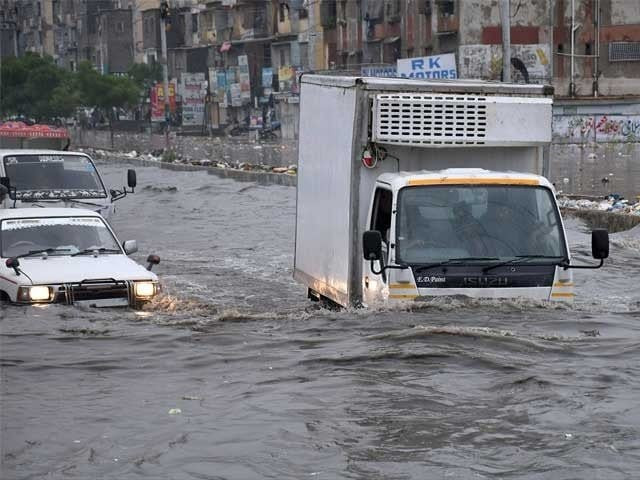Sindh, Balochistan receive over 500% more rain than 30-year average in July
Sherry Rehman says both provinces are still under heavy monsoon pressure for the last 13 days

Rains in Sindh and Balochistan have exceeded the 30-year average as Federal Minister of climate change Sherry Rehman revealed that the former received 625 per cent above average rainfall while the latter saw a 501 per cent increase.
The monsoon rain spell has wreaked havoc in the country with Sindh and Balochistan the most affected provinces. The country has reported at least 147 deaths.
The National Disaster Management Authority said 88 women and children were among the dead. The monsoon rains also damaged homes, roads, bridges and power stations across the country, it said.
Read more: More torrential rains likely in Sindh, Balochistan
Sharing a graph of the Pakistan Meteorological Department (PMD) in a tweet, Sherry said that both provinces are still under heavy monsoon pressure for the last 13 days.
"Sindh is 625% above the 30 year[s] average, Balochistan 501. @pmdgov reports a further rise in heavy rainfall starting tomorrow (Thursday). Again the weather cycle will focus on Sindh, Balochistan for hi[gh] precipitation," she added.
Sindh & Balochistan still under heavy monsoon pressure for the last 13 days. Sindh is 625 % above the 30 year average,Balochistan 501. @pmdgov reports a further rise in heavy rainfall starting tomorrow. Again the weather cycle will focus on Sindh,Balochistan for hi precipitation pic.twitter.com/LzXsSvhB6d
— SenatorSherryRehman (@sherryrehman) July 13, 2022
The first column of the graph describes the maximum rainfall in different places from July 1 to 13. The other one shows the rainfall in 2022 during the same period in millimetres.
According to the graph, Balochistan records an average of 9.6mm of maximum rainfall from July 1 to 13. However, in the same period this year, the province received around 57.8mm of rainfall -- 48.2mm more than usual.
Similarly, Sindh receives an average of 13.6mm of maximum rainfall from July 1 to 13. However this year during the same period, the province received a downpour of 98.3mm, which is 84.7mm more than its average.
Read more: At least 26 people killed across Sindh due to monsoon rains, says PDMA
The chart also compares other provinces in the same period.
Cause of downpour
A low-pressure area developed in the Bay of Bengal, leading to the rain, meteorologist Mahesh Palawat told Down To Earth. He is the vice-president of Meteorology And climate Change at Skymet Weather, a private Indian company that provides weather forecasting services.
“The pressure area is moving to Odisha, Chhattisgarh, north Telangana and south Madhya Pradesh going up to Gujarat, Sindh and Balochistan,” he explained.
Usually, one or two low-pressure areas develop across central India in a month, he said. “But now a series of them are developing, which can be attributed to climate change,” Palawat said.
He added that rain activity would be very intense in central India. “These weather systems are also approaching Balochistan and Sindh, so these areas will also get rains,” he added.
This monsoon may be the rainiest one in the region, he predicts.
More rains
The PMD has advised authorities concerned to take precautionary measures in wake of torrential rains in Sindh, Balochistan and South Punjab this week.
The vigorous monsoon activity will be the result of continuous penetration of monsoon currents from the Bay of Bengal in upper and central parts of the country as well as another strong monsoon low-pressure area (LPA) approaching Sindh on July 14 (Thursday).
According to the Provincial Disaster Management Authority (PDMA), at least 26 people have been killed in rain-related incidents across Sindh, from June 20 to July 10. In addition to 26 deaths, 11 have been injured within the same period. The highest number of deaths occurred in Karachi.
Under the influence of this weather system, more widespread intermittent heavy to very heavy rain-wind/thundershowers are expected in Karachi, Hyderabad Thatta, Badin, Shaheed Benazirabad, Dadu, Tharparkar, Umerkot, Sanghar, Mirpurkhas, Mithi, Jamshoro, Nosheroferoze, Larkana, Jacobabad, Ghotki, Sukkur, Khairpur, Shikarpur, Qambar Shahdadkot, Kashmore, Zhob, Ziarat, Barkhan, Loralai, Bolan, Kohlu, Kalat, Khuzdar, Lasbela, Awaran, Naseerabad, Jaffarabad, Jhal Magsi, Dera Bugti, Sibbi, Panjgur, Turbat and Pasni from July 14-17.
More intermittent rain-wind/thundershower with isolated heavy falls are expected in Islamabad, Kashmir, Swat, Mansehra, Kohistan, Abbottabad, Haripur, Peshawar, Mardan, Swabi, Nowshera, Kurram, Bannu, Lakki Marwat, Kohat, Mianwali, Sargodha, Hafizabad, Mandi Bahauddin, Rawalpindi, Murree, Attock, Chakwal, Jhelum, Sialkot, Narowal, Lahore, Gujranwala, Gujrat, Sheikhupura, Faisalabad, Jhang, Sahiwal, Okara, Bhakkar, Layyah, Multan, Rajanpur, Dera Ghazi Khan, Bahawalpur, Bahawalnagar, Rahimyar Khan and Khanpur from July 13-15 with occasional gaps.
About the impact of the rain, the met office conveyed that torrential rains may generate urban flooding in Karachi, Hyderabad, Thatta, Badin, Shaheed Benazirabad, Jamshoro, Mirpurkhas, Dadu, Umer Kot, Jacobabad, Larkana, Sukkur, Awaran, Panjgur and Turbat from July 14-17 while in Rawalpindi/Islamabad, Peshawar, Nowshera, Mardan, Faisalabad, Lahore and Gujranwala on July 13 and July 14.
Flash flooding is also expected in local Nullahs of Kirthar range, Bolan, Kalat, Khuzdar, Lasbela, Barkhan, Naseerabad, Kohlu, Zhob, Sibbi and hill torrents of Dera Ghazi Khan from July 14-16 while in Islamabad/Rawalpindi, Abbottabad, Mansehra, Dir and Kashmir on July 13 and July 14.
Rainfall may trigger landslides in Kashmir, Galiyat, Murree, Chillas, Diamir, Gilgit, Hunza, Astore and Skardu during the forecast period.
The PDM also advised travellers and tourists to remain cautious during the forecast period.
"All relevant authorities are advised to remain alert and to take necessary precautionary measures during the forecast period," it added.
Premier alert
Moreover, Prime Minister Shehbaz Sharif also directed the federal and provincial civic bodies to closely monitor the safety measures ahead of the new monsoon spell expected to start this Thursday.
The premier asked the authorities to ensure a proper precautionary system for the people across the country, including Sindh, Balochistan and South Punjab.
PM Shehbaz lauded the National Disaster Management Authority (NDMA) for extending support to provincial governments and institutions in controlling the situation amid heavy rains.
Jason Nicholls, lead senior meteorologist at AccuWeather, an American weather forecasting company, predicted that an active monsoon would continue across India into Pakistan through the weekend.
Active monsoon will continue across C #India into #Pakistan through the weekend. Low off #Odisha coast can reach depression before moving ashore late week. Another low will form off #Gujarat coast around Thursday; more flooding rains likely in Gujarat next few days. pic.twitter.com/Vfdv7kwt0R
— Jason Nicholls (@jnmet) July 12, 2022
Well-marked low near #Odisha coast will drift W & weaken the next day or two. Low forms near #Gujarat coast next 24-48 hours with heavy rain & flooding risk in Gujarat, #Maharashtra & parts of #MadhyaPradesh through Thurs. Areas of heavier rain possible in S #Pakistan Thurs/Fri. pic.twitter.com/s2c1YpKSjo
— Jason Nicholls (@jnmet) July 13, 2022
“The low-pressure area off Odisha coast can reach a depression before moving ashore later this week. Another low will form off the Gujarat coast around July 14,” the expert tweeted, adding more flooding rains were likely to be in Gujarat in the next few days.



















COMMENTS
Comments are moderated and generally will be posted if they are on-topic and not abusive.
For more information, please see our Comments FAQ